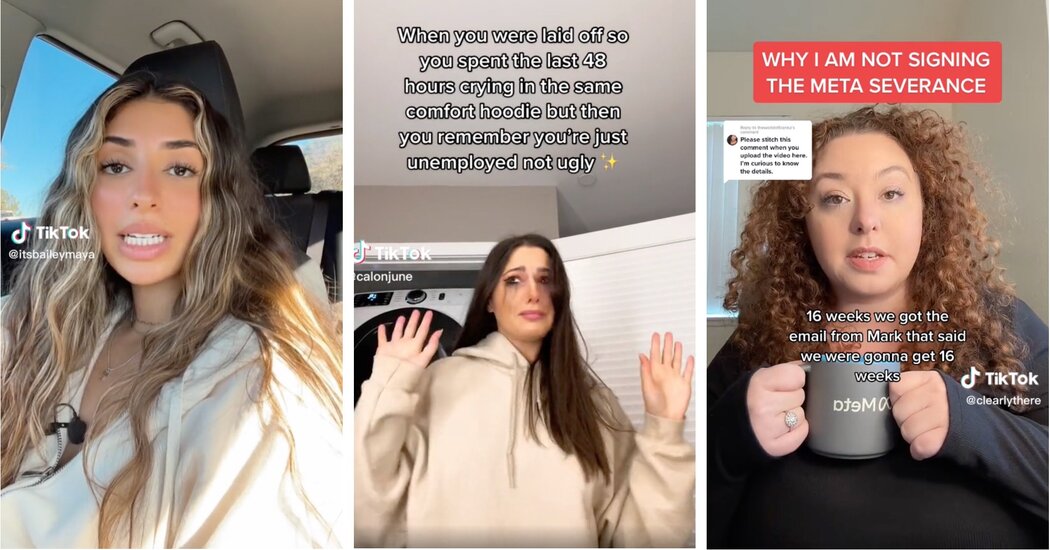
They Lost Their Jobs, Then Went Viral on TikTok
Bailey Harris, 25, worked as a recruiter for a big tech company for more than a year and a half before she was laid off in January. After the initial shock wore off, she decided to tell her story three days later on TikTok. “I was never really worried about layoffs,” she said in the video, which she recorded from a car. “I just didn’t see this coming,” she added.
It was only the second TikTok video Ms. Harris had ever made, but within a day it had more than 100,000 views. That number has since quadrupled.
She continued to post about being newly unemployed. In one, she shared how she was saving money. In another, she told her viewers about a new side hustle helping a friend flip real estate. (These videos performed much better than the others she later posted, which focused on topics like dating, fitness and nutrition.)
“I was like, ‘This is relevant — why not speak about it because I know a lot of people have been going through the same thing?’” she said. The videos, she continued, were “getting a lot of comments about how people like my attitude toward my situation.”
As tech workers continue to get laid off across the country — more than 50,000 employees were let go from Alphabet, Amazon, Meta and Microsoft alone in the last few months — some have turned to TikTok to share their experiences.
An emerging microgenre on the platform, layoff vlogs can be a source of validation and community, or a self-esteem boost, for young workers who have recently lost their jobs. In these videos, some creators vent about their former employers or expose perceived wrongdoings. Others have a more practical objective in mind: using the platform to find their next gig.
Mass layoffs by companies are hardly new, and neither is the idea that former employees will find an outlet to talk about what happened to them. When some nine million Americans lost their jobs in the 2008 financial crisis, workers might have called each other, met up at a bar or posted on Facebook and Twitter.
And during the last major economic upheaval at the beginning of the pandemic — over a single week in March, more than three million Americans became unemployed — TikTok was another available avenue. But while some workers did use the platform for talking about layoffs, a majority of the videos didn’t resonate as they do now.
“This is the first time employees can get laid off, and press record on their phone and have something go mega-mega-megaviral,” said Gabrielle Judge, a content creator who helps women find jobs in tech. She noted that platforms like Facebook or LinkedIn, where disgruntled employees might have gone in the past to vent, don’t have the same viral potential as TikTok.
Calon DiPiero, 30, said that when she was laid off last month from an event planning job at Attentive Mobile, an S.M.S. marketing platform, she filmed a TikTok video to keep her situation in perspective. The caption read: “When you were laid off so you spent the last 48 hours crying in the same comfort hoodie but then you remember you’re just unemployed not ugly.” Posting the video helped her overcome the shame she felt when she was first let go, she said.
“Initially, if this happens, your ego gets bruised,” Ms. DiPiero said. “But then if you can take a step back and say, OK, this is happening to a lot of people. It’s not a personal vendetta against me.”
Tech recruiters said TikTok could be helpful for networking and job hunting. Dozens of companies, including Target, Chipotle and Sweetgreen, have used the app for hiring.
“If you say in a video that you would love to connect with anyone who has a role for you, a lot of people will see it,” said Jonathan Javier, the chief executive and founder of Wonsulting, which helps people, especially those who come from nontraditional backgrounds, find jobs in tech.
The trick, Mr. Javier said, is to strike the right tone: “If you are a prospective employer, seeing someone vent about a past employer can be a red flag. I encourage everyone to stay positive, to focus on the actions you are taking to find a new job.”
Some people are heeding that advice. Ms. Harris, for example, opted not to say which company she worked for in her videos. “Obviously people can do their research and find out where I worked through LinkedIn,” she said. “But I really wanted to stay positive and not name names.”
Brit Levy, 35, who said she was laid off by Meta in November, used TikTok to talk about her frustrations with the severance agreement she said the company was offering, amassing almost 800,000 views. Dozens of former Meta employees reached out to her after the series of videos she posted, she said. “We are finding a little community with each other,” said Ms. Levy, who lives in Oceanside, Calif.
She said she has also had hiring managers reach out to offer support and give her professional advice on the next steps she should take in her career.
TikTok creators who share details about the circumstances of their layoffs, however, can risk legal trouble, depending on which they talk about. “There are many companies that require you to sign documents to get your severance package,” Mr. Javier said. “If they sign a form, there are legal implications.”
Ms. Levy said she wasn’t worried about the potential consequences of speaking publicly about a former employer.
“Honestly, they should be worried about ramifications from me,” she said. “I now know how to get eyes on an issue I feel is super important.”




